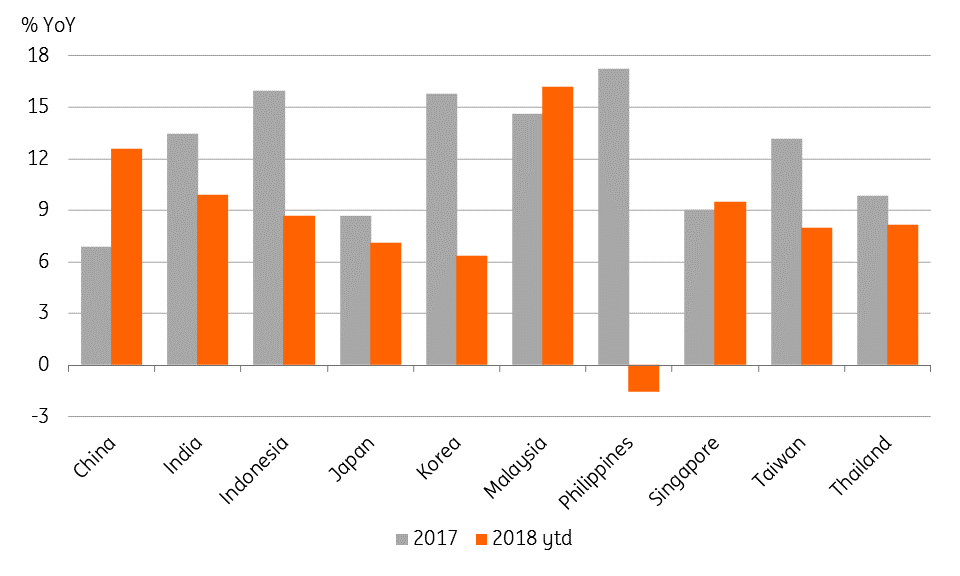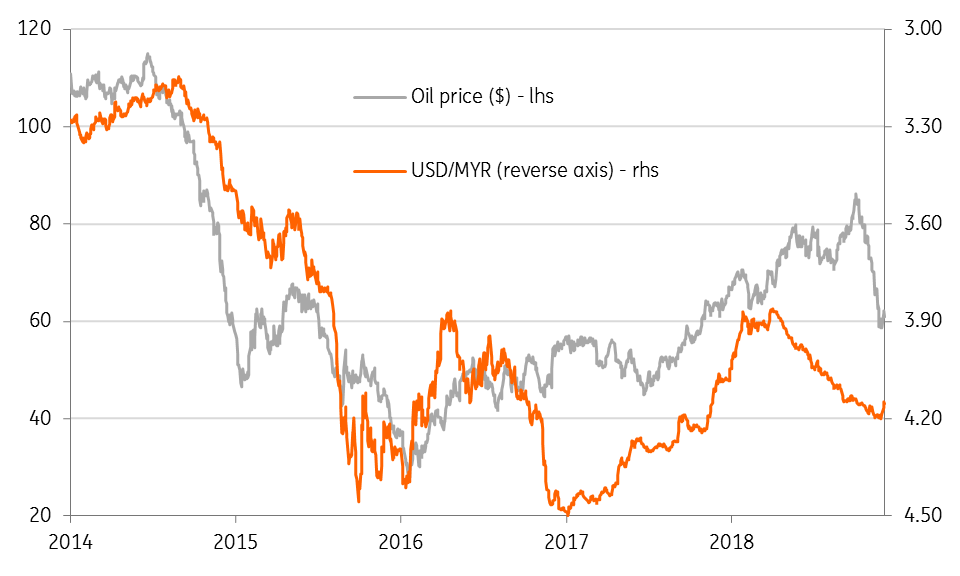Malaysia: October trade surplus at all-time high
The external payments position will remain supportive of the Malaysian ringgit into 2019. But a widely expected global growth slowdown and the resultant double whammy to the economy from slower exports and lower commodity prices will be negative
| MYR 16.3bn |
October trade surplusA record high |
| Higher than expected | |
A record high trade surplus
Malaysia’s trade surplus widened to a record 16.3 billion Malaysian ringgit (MYR) in October from MYR 15.3 billion in September. A surprise 17.7% rebound in exports from a year ago contributed to the higher trade surplus even as imports also posted a significant positive swing to 11.4% annual growth from a 2.8% fall in September. Both export and import growth were way above the consensus estimates of 5.8% and 3.3%, respectively.
Electrical and electronics and commodity cluster (liquefied natural gas, crude petroleum, petroleum products, and palm oil) remained the main export drivers. A 60% surge in semiconductor exports stood out. Strong exports pulled imports higher as most of the (raw material) imports are processed for exports. By-products, electronics and electricals, crude and petroleum products, chemicals, metals, and transport equipment helped headline import growth.
Improved terms of trade
The year-to-date export and import growth rates of 7.5% and 5.4% have slowed sharply from over 20% a year ago. Yet, the USD-denominated 16% growth rate makes Malaysian exports Asia's star performers in the current year. Unlike most Asian economies, Malaysian export growth accelerated this year (see figure).
A wide gap between the MYR- and USD-denominated export growth rates is explained by the movement in the exchange rate. The average USD/MYR rate of 4.01 in the first 10 months represents a more than 8% appreciation from the average rate in the same period of 2017, though the currency was still down 3% from its end-2017 level. Stripping out the price effect, the year-to-date growth in the volume of exports halved to 6% from a year ago.
However, Malaysia’s export outperformance vis-à-vis other Asian countries in an environment of intensified global trade conflict this year may as well be ascribed to better terms of trade from higher commodity prices. Even as most of the oil price surge seems to be over, the $72/barrel year-to-date average oil price is still 34% higher than the average a year ago.
Asia: Export performance - Year-to-date 2018 vs. 2017

Positives and negatives for the MYR
The cumulative trade surplus of MYR 102 billion in the first 10 months was MYR 21 billion wider on the year. The trade surplus drives the current account surplus, though the latter shrank by MYR 3.7bn to MYR22.7bn in the first three quarter of 2018. We expect the full-year 2018 current surplus to be equivalent to 2.2% of GDP, down from 3.0% in 2017 but still far better than some other Asian economies (India, Indonesia, and the Philippines). We anticipate the current account surplus to remain within the 2-3% of GDP range in 2019, which is also the government’s projection for the year.
The external payments position will remain supportive of the MYR into 2019 but a widely expected global growth slowdown and the resultant double whammy to the economy from slower exports and lower commodity prices will be negative. Among other things, Malaysia's weak public finances are the key headwind to currency appreciation. Overall, we expect the economic outlook to be mildly negative for the MYR, guiding us to a view that the USD/MYR will hover near the 4.2 level through 2019 (spot 4.15).
Oil drives Malaysian ringgit

Download
Download article
6 December 2018
Good MornING Asia - 6 December 2018 This bundle contains {bundle_entries}{/bundle_entries} articles"THINK Outside" is a collection of specially commissioned content from third-party sources, such as economic think-tanks and academic institutions, that ING deems reliable and from non-research departments within ING. ING Bank N.V. ("ING") uses these sources to expand the range of opinions you can find on the THINK website. Some of these sources are not the property of or managed by ING, and therefore ING cannot always guarantee the correctness, completeness, actuality and quality of such sources, nor the availability at any given time of the data and information provided, and ING cannot accept any liability in this respect, insofar as this is permissible pursuant to the applicable laws and regulations.
This publication does not necessarily reflect the ING house view. This publication has been prepared solely for information purposes without regard to any particular user's investment objectives, financial situation, or means. The information in the publication is not an investment recommendation and it is not investment, legal or tax advice or an offer or solicitation to purchase or sell any financial instrument. Reasonable care has been taken to ensure that this publication is not untrue or misleading when published, but ING does not represent that it is accurate or complete. ING does not accept any liability for any direct, indirect or consequential loss arising from any use of this publication. Unless otherwise stated, any views, forecasts, or estimates are solely those of the author(s), as of the date of the publication and are subject to change without notice.
The distribution of this publication may be restricted by law or regulation in different jurisdictions and persons into whose possession this publication comes should inform themselves about, and observe, such restrictions.
Copyright and database rights protection exists in this report and it may not be reproduced, distributed or published by any person for any purpose without the prior express consent of ING. All rights are reserved.
ING Bank N.V. is authorised by the Dutch Central Bank and supervised by the European Central Bank (ECB), the Dutch Central Bank (DNB) and the Dutch Authority for the Financial Markets (AFM). ING Bank N.V. is incorporated in the Netherlands (Trade Register no. 33031431 Amsterdam).